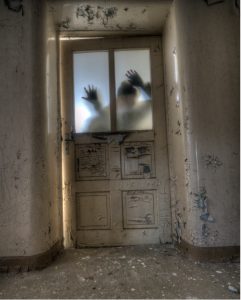Posted October 3, 2023 by Krista Collier-Jarvis
My First Encounter with the Gothic: Krista Collier-Jarvis
My first encounter with the Gothic precedes my knowledge of the existence of Gothic itself. As such, it can be quite difficult to pinpoint exactly where that encounter manifested…

As a child, my memories of quality time with my mom were often in relation to horror films. On the weekends, we would curl up on the couch with snacks and watch the latest gorefest, such as the newest Halloween, a rerun of Pet Sematary, or a classic like Silver Bullet. It was not fear that I felt from these moments, but a kind of enjoyment within a safe space that shaped my understandings of “real-world” horrors versus how they are represented.

My love of horror movies translated well in my English classes when we read short stories and novels that took up Gothic topics. I was drawn to the writings of Charlotte Perkins Gilman, Eudora Welty, and Edgar Allan Poe. My favorite Shakespeare play was Titus Andronicus (I couldn’t stop myself from researching the amount of blood used in the various adaptations). While not a Gothic text per se, Titus Andronicus felt like an Early Modern embodiment of the horror movies that shaped my childhood. I found myself drawn to reading and writing exclusively about the Gothic. I just didn’t know that what I encountered was Gothic.
The first time a professor named the genre as “Gothic” illuminated and reframed my relationship with those narratives.
When exploring options for my honours research, I initially met with Dr. Karen Macfarlane (MSVU). I was unsure what to focus on for a project of this length. She asked me what I thought I could talk about for a year, and I quickly responded with “The Walking Dead,” which I personally consider to be my first encounter with the Gothic.
Discovering The Walking Dead

In high school, a close friend of mine was moving away. As a goodbye gift, he gave me my first comic books—the entire series of Lady Death: A Medieval Tale (2003). Yes, I resisted comic books during my childhood; I couldn’t possibly understand what the big deal was. I was immediately enthralled with the dark and beautiful artwork in Lady Death, with the representation of death as a powerful force, and with the serialisation of a story that kept me coming back for more. These stories were nuanced, complex reworkings of the very things I already adored in film and literature.
After completing the series, I felt hungry for more, so I visited the local comic book shop for the first time. I walked in the door and up to the first shelf and sitting front and center was the latest issue of the The Walking Dead; it was issue #9 (2004)—the one where Carl is accidentally shot by Otis. The cover made me uncomfortable with its peeling eye and oversized fly. I read through it so fast, enveloped by the story to the point where I didn’t even realise it was in black and white. I hunted down the first 8 back issues and thus my obsession began.
My honours research addressed the representation of pregnant women and newborns in The Walking Dead comics, and because the television adaptation was released partway through that year, I included some early scenes from the show. My Master’s thesis built upon this work; I looked at the little girl zombies in The Walking Dead as well as a host of other zombie narratives. I am now completing my PhD dissertation, and while I’ve turned away from The Walked Dead for the most part, I will most likely never be able to turn away from the Gothic. I’m hooked for life!
